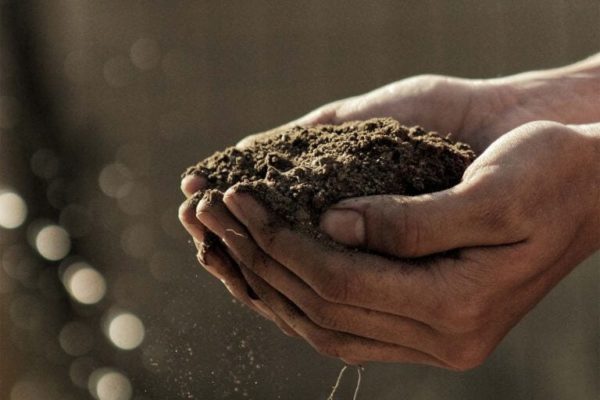Soil – Little Word, Big Meaning

Soil. Earth. Dirt. We have many words for it, but what exactly is it? Ask a kindergartener and they might answer that it’s what they make mud pies out of. Ask someone with a garden and they might say that it provides plants with nutrients. Though neither the kindergartener or the gardner are wrong, they’re not completely correct either. So let’s get into what exactly it is and why it’s important for your landscaper to understand it.
WHAT IS SOIL?
According to the Soil Science Society of America, soil is “(i) The unconsolidated mineral or organic material on the immediate surface of the Earth that serves as a natural medium for the growth of land plants.” Soil and earth are nearly synonymous – there’s a reason that earth is another word for soil. Nearly everything that we do on solid ground is undergirded by soil. From gardens and lawns, to roads and buildings, it is the foundation.
HOW SOIL AFFECTS PLANT GROWTH
Everyone knows that soil quality affects plant growth. You can’t plant a flower in sand and expect it to grow. That’s because the properties of sand aren’t conducive to growing flowers. With every landscaping project, you should start by making a plan. Understanding the properties of the soil you’re working with is crucial, as it will dictate whether your garden or landscaping project will flourish.
There are 5 crucial properties of soil that should always be considered: texture, structure, density, pH, and organic matter.
TEXTURE: Texture refers to the amounts of sand, silt, and clay in a particular soil. Bear in mind that these terms refer to the particle size rather than a specific mineral. Sand is the largest size – sand grains are visible to the naked eye. Clay is the smallest size particle – individual clay grains are only visible with an electron microscope. Silt is the middle size particle and can be seen under a regular microscope. The proportions of these particles affect the texture of the soil.
STRUCTURE: Often in soils, the comprising particles will clump, or aggregate together. This aggregation defines its structure. There are many ways to describe a soil’s structure, such as blocky, platy, prismatic, and angular.
DENSITY: Soil particles don’t fit together perfectly. The space in between each particle is called pore space, and these pore spaces affect the density. The density of the soil dictates how well it retains water. However, there is a fine line between a soil that is dense enough to have good water retention and one that is too dense to promote plant growth. The ideal soil for growing plants is 50% soil and 50% pore space.
pH: pH is the measure of how alkaline or acidic a substance is. The pH scale runs from 0 (very acid) to 14 (very alkaline), with a pH of 7 being completely neutral. Soils generally range between 4-8 pH. The pH is important to consider, as it affects the availability of nutrients.
ORGANIC MATTER: Many organisms, such as bacteria, fungi, algae, insects, and worms, live in different soils. These organisms are important to plant growth, as their secretions help dissolve minerals that provide nutrients for the plants. Larger organisms, like insects and worms help to decompose other organic materials and provide nutrients, as well as aerate the soil. A soil that is devoid of organic matter is not a soil that will grow healthy plants.
HOW SOIL AFFECTS BUILDINGS
If you’ve ever seen a picture of the Leaning Tower of Pisa, you’ve seen why understanding soil is crucial when building a structure. If the engineers of the Leaning Tower of Pisa knew what we knew now, they would have realized that the soft, silty sand of the site was not a dense enough soil to support the weight of the building. More than that, they would have known about the fluctuating water table beneath the soil that is the primary cause of the tower’s famous lean.
Fortunately, the field of geotechnical engineering exists to make sure that modern-day buildings and skyscrapers don’t succumb to the same structural flaw as the Leaning Tower of Pisa. Geotechnical engineering is a field of civil engineering that analyzes the properties of soil and rock that affect the performance of buildings, dams, pavements, and underground facilities. These engineers understand the mechanics of soil and rock and how they affect subsurface conditions and materials. A geotechnical engineer can tell you exactly how the soil of a proposed building site will affect the building.
HOW A LANDSCAPE ARCHITECT CAN HELP
As evidenced above, soil is more than just dirt. The number of different things to consider when thinking about it can seem overwhelming to the average homeowner, and that’s where a landscape contracting firm like DSLD Land Management can help! DSLD is well versed in both the organic as well as the structural properties of soil and can help you make the best decisions for your landscaping based on the soil around your house. And with DSLD, you’ll get the geotechnical experience of our owner David Sharp, who has over 30 years of combined geotechnical and horticultural experience, as well as DSLD’s team of civil engineers and landscape architects.
DSLD is a full-service design/build landscape contracting firm located in Birmingham. The family-owned and operated company is headed up by David Sharp, a brilliant design engineer who is backed by a team of professionals that have decades of experience in taking Alabamians’ landscape nightmares and turning them into dreamscapes. They do commercial and residential. I speak from experience here AlabamaWX friends: Give David and his team a call. They’re amazing! – Bill Murray
Category: ALL POSTS, Partner News Stories



















